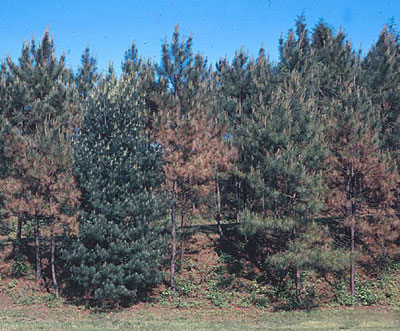Needlecast
Natural History

Needlecast affected and non-affected pines | Photo credit: G. Blakeslee - SFRC, Univ. of Florida
Needlecast is a common disease of conifers in the South, and can affect all major pine species in Florida. More than 25 types of fungi cause the disease, which can slow tree growth. Damage is rarely serious, and although the trees may appear unsightly as if scorched by fire, most trees recover the following year - producing new, healthy growth.
New needles are usually infected with the fungi in the spring or summer. By the following winter or early spring, needles turn red, yellow, or brown depending on the type of fungi.
In the affected areas, black fruiting bodies produce microscopic spores called ascospores. During wet weather, the fruiting bodies open along a slit and the spores are released. Wind and rain carry the spores to new trees where new infections begin. Trees may drop infected needles, leaving only new, healthy growth.
